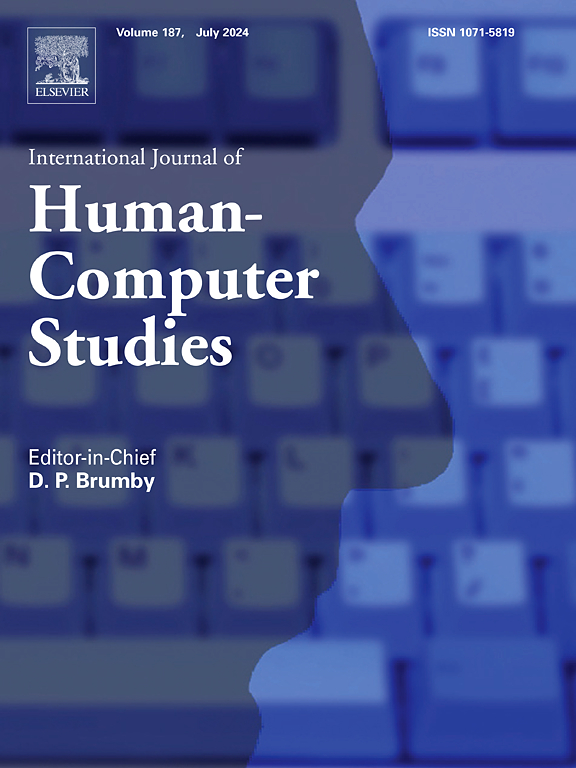Exploring children’s embodied interactions through digitally facilitated enactment: A case study when math education MOVES
IF 5.3
2区 计算机科学
Q1 COMPUTER SCIENCE, CYBERNETICS
International Journal of Human-Computer Studies
Pub Date : 2025-05-08
DOI:10.1016/j.ijhcs.2025.103509
引用次数: 0
Abstract
Technology-enhanced embodied learning has gained traction in HCI, yet deeper insights into how children’s physical actions interplay with their cognitive and emotional states remain underexplored. This study investigates MOVES-NL, an embodied digital learning environment, as a medium for advancing understanding of the dynamic relationship between movement, engagement, and cognitive processes such as stress and learning. MOVES-NL combines movement and immediate formative feedback to foster arithmetic understanding of integers, offering a novel perspective on the integration between embodied interactions and conceptual development. Moving beyond traditional evaluations of learning impact or media comparisons, this work employs multimodal learning analytics (MMLA) integrating motion capture with physiological data to explore the nuanced dynamics of embodied learning. Through a mixed-methods approach integrating both qualitative and quantitative analyses, this study reveals how students’ physical movements relate to cognitive and emotional states, offering actionable insights to support engagement and learning processes. This research advances the understanding of how children’s physical movements relate to their cognitive processes and highlights key considerations for integrating embodied technologies into curricula to foster student engagement and deepen their conceptual understanding, adding value to ongoing conversations about the role of digital technology in children’s education and development.
通过数字促进的制定探索儿童的具体互动:数学教育移动的案例研究
技术增强的具身学习已经在HCI中获得了吸引力,但关于儿童的身体行为如何与他们的认知和情绪状态相互作用的更深入的见解仍未得到充分探索。本研究探讨了MOVES-NL这一具体的数字学习环境,作为促进对运动、参与和认知过程(如压力和学习)之间动态关系的理解的媒介。MOVES-NL结合了运动和即时形成反馈,以促进对整数的算术理解,为体现互动和概念发展之间的整合提供了一个新的视角。超越传统的学习影响评估或媒体比较,本研究采用多模态学习分析(MMLA),将动作捕捉与生理数据相结合,探索具身学习的细微动态。通过结合定性和定量分析的混合方法,本研究揭示了学生的身体运动与认知和情绪状态的关系,为支持参与和学习过程提供了可行的见解。这项研究促进了对儿童身体运动与认知过程之间关系的理解,并强调了将具体技术整合到课程中的关键考虑因素,以促进学生的参与并加深他们的概念理解,为正在进行的关于数字技术在儿童教育和发展中的作用的对话增加了价值。
本文章由计算机程序翻译,如有差异,请以英文原文为准。
求助全文
约1分钟内获得全文
求助全文
来源期刊

International Journal of Human-Computer Studies
工程技术-计算机:控制论
CiteScore
11.50
自引率
5.60%
发文量
108
审稿时长
3 months
期刊介绍:
The International Journal of Human-Computer Studies publishes original research over the whole spectrum of work relevant to the theory and practice of innovative interactive systems. The journal is inherently interdisciplinary, covering research in computing, artificial intelligence, psychology, linguistics, communication, design, engineering, and social organization, which is relevant to the design, analysis, evaluation and application of innovative interactive systems. Papers at the boundaries of these disciplines are especially welcome, as it is our view that interdisciplinary approaches are needed for producing theoretical insights in this complex area and for effective deployment of innovative technologies in concrete user communities.
Research areas relevant to the journal include, but are not limited to:
• Innovative interaction techniques
• Multimodal interaction
• Speech interaction
• Graphic interaction
• Natural language interaction
• Interaction in mobile and embedded systems
• Interface design and evaluation methodologies
• Design and evaluation of innovative interactive systems
• User interface prototyping and management systems
• Ubiquitous computing
• Wearable computers
• Pervasive computing
• Affective computing
• Empirical studies of user behaviour
• Empirical studies of programming and software engineering
• Computer supported cooperative work
• Computer mediated communication
• Virtual reality
• Mixed and augmented Reality
• Intelligent user interfaces
• Presence
...
 求助内容:
求助内容: 应助结果提醒方式:
应助结果提醒方式:


